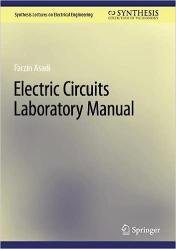Electric Circuits Laboratory Manual
- Добавил: literator
- Дата: 28-03-2023, 04:55
- Комментариев: 0
 Название: Electric Circuits Laboratory Manual
Название: Electric Circuits Laboratory ManualАвтор: Farzin Asadi
Издательство: Springer
Год: 2023
Страниц: 177
Язык: английский
Формат: pdf (true)
Размер: 10.2 MB
This book provides insights into practical aspects of electric circuits. The author provides real-world examples throughout this book. The devices chosen for this book can be found in nearly all laboratories. No expensive measurement devices are used throughout the book. Someone who reads this book has a better understanding of practical aspects of electric circuits. Chapter 1 introduces tools that will be used in the next chapters. Chapter 2 studies the resistors and contains 9 experiments. Chapter 3 studies the digital multimeters and contains 7 experiments. Chapter 4 studies Kirchhoff's voltage/current law, nodal/mesh analysis and Thevenin equivalent circuits. This chapter contains 5 experiments. Chapter 5 studies the first and second order circuits (RC, RL and RLC) and contains 4 experiments. Chapter 6 studies the DC and AC steady state behavior of electric circuits and frequency response of filters and has 5 experiments. Chapter 7 studies magnetic coupling and transformers and contains 3 experiments. Appendix A shows how different types of graphs can be drawn with MATLAB. Appendix B reviews the concept of root mean square.
Digital multimeters are measuring instruments that can measure quantities such as voltage, current, and resistance. Measured values are shown on a digital display, allowing them to be read easily and directly, even by first-time users. Study the user manual of the DMM that you will use in the experiments. Ensure that you are able to do the followings:
(a) Measurement of resistance.
(b) Measurement of AC/DC voltages.
(c) Measurement of AC/DC currents in the range of Amps.
(d) Measurement of AC/DC currents in the range of milli/micro Amps.
A function generator (sometime is called signal generator) is used to generate different types of electrical waveforms over a wide range of frequencies. Some of the most common waveforms produced by the function generator are the sine wave, square wave, triangular wave and saw tooth shapes. The FG’s are divided into two groups: Analog FG’s and Direct Digital Synthesis (DDS) FG’s. As the name suggests, the analog FG’s, uses the analog circuits in order to produce the output waveform. DDS FG’s use digital circuits (i.e. a microprocessor) in order to produce the output waveforms. Accuracy of DDS signal generators is better than analog signal generators.
Beside the standard waveforms (i.e. sinusoidal, square, triangular and saw tooth), some DDS FG’s are able to produce arbitrary waveforms. These type of FG’s are called Arbitrary Waveform Generator (AWG). They have software which permits you to draw the waveform that you want. After drawing the waveform in the software environment, the hardware of AWG produces the waveform for you.
Resistors play an important role in electric and electronic circuits. In the Chapter 2 you will learn about different types of resistors, Ohm’ law, how to measure the resistance using Digital Multi Meter (DMM) and how to convert a current signal into a voltage signal.
Скачать Electric Circuits Laboratory Manual
Внимание
Уважаемый посетитель, Вы зашли на сайт как незарегистрированный пользователь.
Мы рекомендуем Вам зарегистрироваться либо войти на сайт под своим именем.
Уважаемый посетитель, Вы зашли на сайт как незарегистрированный пользователь.
Мы рекомендуем Вам зарегистрироваться либо войти на сайт под своим именем.
Информация
Посетители, находящиеся в группе Гости, не могут оставлять комментарии к данной публикации.
Посетители, находящиеся в группе Гости, не могут оставлять комментарии к данной публикации.
